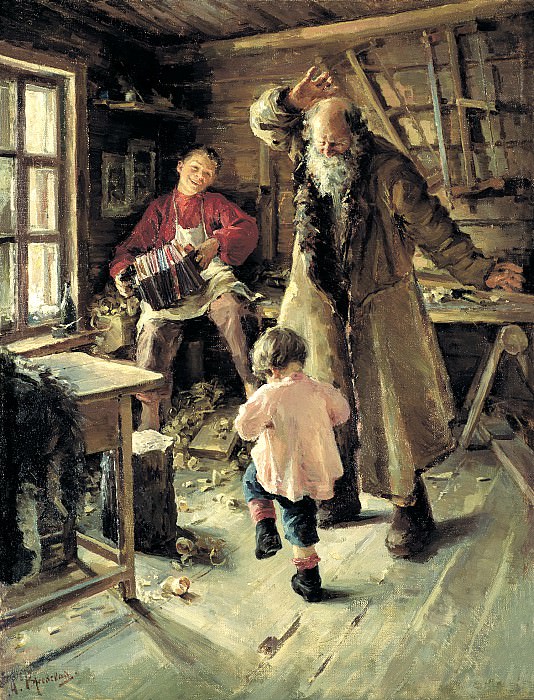RZHEV Antonina – Merry minute 900 Classic russian paintings
RZHEV Antonina - Merry minute
Edit attribution
Download full size: 1500×1968 px (1,6 Mb)
Back to album: 900 Classic russian paintings
1897; canvas, oil; 83 x 64; Tretyakov Gallery. "Merry Minute" is the most recognizable of the works of artist Antonina Leonardovna Rzhevskaya. A descendant of an impoverished noble family from Tver, Antonina Leonardovna studied in the Mariinsky Gymnasium and then, after moving to Moscow, completed courses at the Moscow Academy of Painting, Sculpture and Architecture. Her paintings are full of life and light, they are often simple everyday scenes, as if accidentally spotted in the most ordinary homes. Such is the case of the "Jolly Minute", a painting that is loved by many generations, a canvas that brings an involuntary smile of joy when you look at it.
Description of Antonina Rzhevskaya’s painting "A Merry Minute"
1897; canvas, oil; 83 x 64; Tretyakov Gallery.
"Merry Minute" is the most recognizable of the works of artist Antonina Leonardovna Rzhevskaya. A descendant of an impoverished noble family from Tver, Antonina Leonardovna studied in the Mariinsky Gymnasium and then, after moving to Moscow, completed courses at the Moscow Academy of Painting, Sculpture and Architecture. Her paintings are full of life and light, they are often simple everyday scenes, as if accidentally spotted in the most ordinary homes.
Such is the case of the "Jolly Minute", a painting that is loved by many generations, a canvas that brings an involuntary smile of joy when you look at it. Dynamic, executed almost exclusively in light colors, full of motion. Looking at the presented subject, the viewer can hear, as if in reality, the sounds of music filling the small room of a wooden hut, where the grandfather and his two grandchildren are having fun.
In the foreground is the figure of a young boy, flooded with light. The child stands with his back to the viewer, wearing a loose shirt, short pants and shoes, stomping in place to the sounds of the harmonica, played by his older brother, who is seated on the bench in the left corner of the picture. The teenager with the harmonica is no more than fourteen years old, wearing a white apron over a scarlet shirt, and he has clearly only been away from work for a moment. Perhaps he was distracted by the arrival of his grandfather, who is depicted in the picture in a street coat. The old man with a white beard is dancing around selflessly, admiring his little grandson.
The whole action of the scene takes place in the studio. Sawdust is scattered around the three characters, and carpentry tools hang on the back wall of the room. It is obvious that work is boiling here, and only for a short time has labor given way to entertainment.
Кому понравилось
Пожалуйста, подождите
На эту операцию может потребоваться несколько секунд.
Информация появится в новом окне,
если открытие новых окон не запрещено в настройках вашего браузера.
You need to login
Для работы с коллекциями – пожалуйста, войдите в аккаунт (open in new window).




















COMMENTS: 1 Ответы
класс
You cannot comment Why?
To the right, an older man with a long white beard, dressed in a traditional brown coat, stands with his arms outstretched, seemingly engaged in a dance or vigorous movement, his face also conveying a sense of mirth. He appears to be reacting to the music, perhaps clapping or gesturing rhythmically.
In the foreground, a small child, a toddler, is shown from behind, dressed in a light pink shirt and blue pants with red-striped socks, wearing dark boots. The child is in motion, possibly dancing or toddling towards the older man, their back to the viewer. The floor of the workshop is scattered with wood shavings, indicating that it is an active workspace. Sunlight streams in from a window on the left, illuminating dust motes and casting long shadows.
The subtext of the painting revolves around themes of intergenerational joy, music, and simple domestic life. The vibrant energy of the scene suggests a moment of uninhibited celebration and shared happiness. The contrast between the young boy playing music, the ecstatic older man, and the toddling child hints at the cyclical nature of life and the passing down of traditions and the joy found in them. The setting of the rustic workshop adds a sense of authenticity and groundedness to the scene, suggesting that happiness can be found in everyday moments and simple pleasures. The overall impression is one of warmth, familial love, and the pure, unadulterated joy of shared experience.